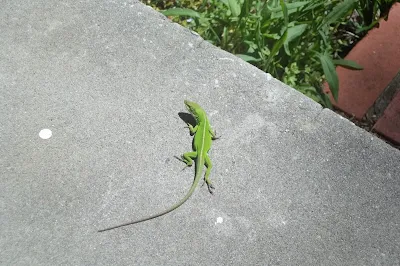_by_Robert_Michniewicz.jpg) |
| The beautiful green and brown Carolina anole lizards. |
On Wednesday, February 18, even though it did not get above 25F for a high in South Carolina, and the windchill felt like single digits, that did not stop this little lady from crawling out from under the house this afternoon to get her some sunshine. I'd seen her crawl out from under the house before with a pair of little ones, but this is the first time she let me get close enough to get a really clear photo of her.
A native species to North America found mainly in
the American Southland and the Caribbean, the Carolina anole (Anolis
carolinensis) is a small, hardy little lizard that's active all year
around. They are arboreal in nature but may be seen on the ground and
frequently seen on shrubs and trees, but is also a common sight in urban areas
on steps, porches, railing, and foliage adjacent to houses.
Anoles are most abundant on the Atlantic Coastal Plains in North Carolina, South Carolina, Georgia and Florida, and on the Gulf Coast in Alabama, Mississippi, Louisiana, and Texas and have been found as far north as Southern Tennessee and southeastern Virginia. In the Carolinas they are found in the coastal plains and southern piedmont regions of North Carolina, but throughout South Carolina, while in Georgia they are widespread except in the Blue Ridge region.
Anoles are most abundant on the Atlantic Coastal Plains in North Carolina, South Carolina, Georgia and Florida, and on the Gulf Coast in Alabama, Mississippi, Louisiana, and Texas and have been found as far north as Southern Tennessee and southeastern Virginia. In the Carolinas they are found in the coastal plains and southern piedmont regions of North Carolina, but throughout South Carolina, while in Georgia they are widespread except in the Blue Ridge region.
Other common names for the anole are: The green
anole, American anole, and red-throated anole. It is also
sometimes referred to as the American
chameleon due to its ability to change color from several brown hues to
bright green - although it is not a true chameleon. They are from a family of lizards called Dactyloidae, and more closely related to the iguana, though they are sometimes confused with geckos.
 | |
| Its easy to see how the Carolina anole can be mistaken from the Gecko....and no thanks mate, I already have car insurance. |
These little critters are truly amazing creatures. They are harmless to humans, but do not necessarily make good pets. As a kid, I would catch them and put them in an old empty aquarium - least till my folks put them back outside. They need to be outside where they can roam free.
Other times when I sat on my porch drinking iced tea in the summertime, I would see the occasional anole crawl onto the porch and stare at me as I looked back at them. Sometimes I find them inside my house and carefully put them back outside.
The beautiful Carolina anole is truly one of Dixie's many wonders and a hardy Southern lizard.


No comments:
Post a Comment